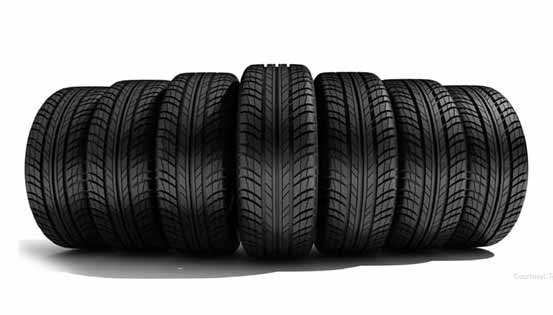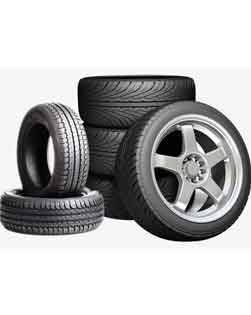An automobile tire is defined as a tire consisting of a rubber ring around the rim of an automobile wheel. It is usually made of rubber and filled with compressed air. For all sorts of vehicles, there are automobile tires with numerous rating systems. Tyres have ratings for traction, tread wear, and resistance of temperature which is known as UTQG ratings. There are speed as well as load ratings. Some tires have tread designs which are unidirectional and has a rotation direction indicated by an arrow. This arrow marking shows the way the tyre should rotate when the vehicle is moving forwards. Hence, you cannot put a 'clockwise' tire on the left hand side of the car or a 'counter-clockwise' tire on the right side of the car. The rotation of the tire moves tyres between the different wheels of the vehicle as front and back axles carry different loads. This makes the tire wear differently.
Types of automotive tyres
- Performance and racing tires
These tires are meant for use at higher speeds. They have a softer rubber compound for traction improvement, especially on high speed cornering. The ability to provide an efficient level of performance on both wet and dry pavement depends widely on the manufacturers and even tire models of the same manufacturer. This area requires active research and development, as well as marketing. The highest performance tires driven on the street are often called as summer or three-season tires.


This is because they are optimized for ultimate warm weather wet and dry performance. However, they must be replaced with winter or all-season tires if the vehicle is driven much during the winters.
Winter tires are manufactured to provide efficient performance under winter conditions compared to tires used in summers. The rubber compound used in the tread of the winter tire is usually softer than that used in tires for summer conditions. This provides a better grip on ice and snow but wears more quickly at higher temperatures. Winter tires have fine grooves and siping in the tread patterns and are usually removed for storage in the spring. This is because the rubber compound becomes too soft in warm weather which results in a reduced tire life.
These tires are developed for use on dry and wet roads during summer and also for use during winters. The type of rubber and the tread pattern which is suitable for use during summer is not suitable to give good performance during winter for technical reasons. The all-season tire is a compromise between the two. The all-season tire is neither an excellent summer tire nor an excellent winter tires.
These tires are typically used on SUVs and light trucks. The all-terrains tires have stiffer sidewalls for greater resistance against puncture while traveling off-road. The tread pattern offers wider spacing than all-season tires to remove mud from the tread. Within the all-terrain category types of tires, many of the tires available are designed primarily for on-road use.
Mud tires have large, chunky tread patterns which are designed to bite into muddy surfaces. The large open design also helps the mud to clear quickly from between the lugs. These tires are wider than other tires so as to prevent the vehicle from sinking too deeply into the mud. Besides this, the composition and tread pattern doesnot allow mud terrain tires to perform well on on-road use.
- Anti Vibration Mountings
- Automobile Rubber Products
- Calendered Rubber Products
- Extruded Rubber Products
- Medical Rubber Products
- Metal Bonded Components
- Rubber Adhesives & Sealants
- Rubber Ball
- Rubber Bands
- Rubber Beading
- Rubber Bearing
- Rubber Belt
- Rubber Buckets
- Rubber Bullets
- Rubber Cable
- Rubber Coating
- Rubber Duct
- Rubber Expansion Joints
- Rubber Flooring/Matting
- Rubber Footwear
- Rubber Gloves
- Rubber Injection Parts
- Rubber Lining
- Rubber Magnets
- Rubber Molded Products
- Rubber Pads
- Rubber Rollers
- Rubber Stopper
- Rubber Suit
- Rubber Track
- Rubber Valve
- Rubber Balloon
- Rubber Stamps
- Rubber Fenders
- Acrylic Rubber (ACM)
- Butadiene Rubber (BR)
- Butyl Rubber (IIR)
- Chlorosulfonated Polyethylene(CSM)/ Hypalon
- Ethylene Propylene Diene Monomer
- Fluoroelastomers (FKM)/Viton
- Isoprene Rubber (IR)
- Nitrile Rubber (NBR)
- Perfluoroelastomer (FFKM)
- Polychloroprene (CR)/Neoprene
- Polysulfide Rubber (PSR)
- Silicone Rubber (SiR)
- Styrene Butadiene Rubber
How to Make a Custom Rubber Stamp?
Whenever designing a custom stamp for your company, never compromise on its quality because in the end it is the most...
Read MoreLatex and Silicone Rubber Tubing - A Comparison!
Many industries use rubber tubing for various purposes. In fact, various types of rubber tubing are used for different applications...
Read MoreSilicone vs Acrylic Adhesive- A Comparison
Silicon and acrylic adhesives are those rubber adhesives that are widely used in Polyimide tapes. In fact, the polyimide...
Read More

